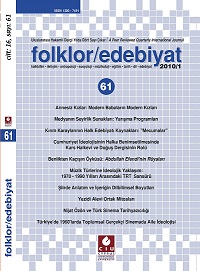Yezidi Ve Alevi Ortak Mitosları
Sharıng Myths In Yezıdısm And Alevısm
Author(s): Ç. Ceyhan SuvariSubject(s): Customs / Folklore, Islam studies, Comparative Studies of Religion, Philosophy of Religion, Sociology of Religion, History of Religion
Published by: Uluslararası Kıbrıs Üniversitesi
Keywords: Alevism; Yezidism; sufism; heretic; heterodoxy; orthodoxy;
Summary/Abstract: In practice, the sect of Alevism and the religion of Yezidism are known different from each other. Lots of researches have been done about both beliefs and theses have been prepared about them. Different views both on Alevism and Yezidism are put forward in those studies. For instance, in studies done on Yezidis, the Yezidism is defined as different opposing perspectives such as a deviation formed by the superstitions of illiterate, atheistic, satan-worshippers and a converted sect from Islam religion and a continuation of Zarathostrianism, and an old Turkish belief originated from Central Asia and a combination of various religions. Similarly, in studies done in connection with the Alevis, the Alevism is defined as a belief of Central Asia origin and a compromise of Shamanism and Islam and a continuation old Persian religions and a continuation of antique Anatolian beliefs and a sect of Islam and a non Islamic belief etc. Yet none of these studies touch on the common points of heterodoxal beliefs like Yezidism and Alevism. In addition to the existing chaos in the definition, when these two beliefs are compared, both in theory and practice, surprising similarities are observed between each other. When looked at their historical backgrounds, we see that both of them in fact are fed by the same source. Here the same source mentioned is sufism for sure. From the early years of Islam religion sufistic movements spreading in a wide geographical area from Middle East and Iran to Anatolia and Balkans have been accepted among the non Arabic communities in Islam through the leadership of mystical disciples called sheiks, masters and dervishes, on the other hand these movements have laid a firm ground for a wide variety of sects in Islam religion since the Islam religion has faced with the different beliefs and then combined with them. Anatolia has provided contribution to this process both as a source and a gateway. Even today Anatolia housing many cultures and beliefs has maintained its historical mission. Though these cultures look different in form, they create a synthesis of a common share in content. Moreover, as will be seen later in the Alevi and Yezidi miths, this sharing / similarity appears not only in materialistic and formal way but also in communal memory. Consequently, in this geography none of these cultural identities and beliefs are discrete and unfamiliar but a synthesis of a common culture formed and shared together.
Journal: Folklor/Edebiyat
- Issue Year: 16/2010
- Issue No: 61
- Page Range: 179-192
- Page Count: 14
- Language: Turkish

